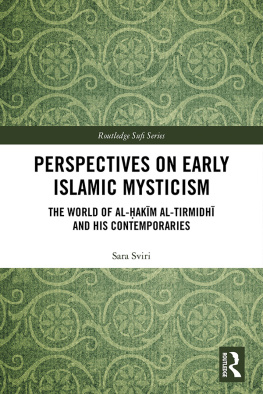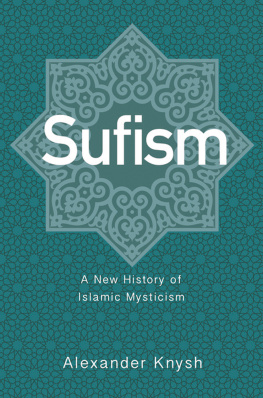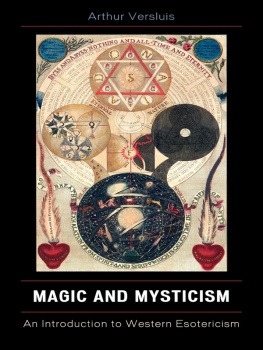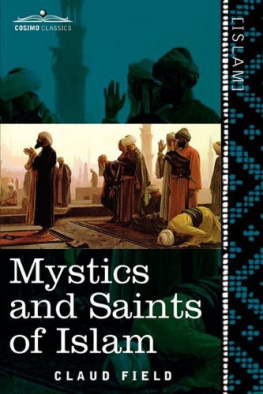First published in 2002
by Curzon Press
This edition published 2012 by Routledge
2 Park Square, Milton Park, Abingdon, Oxfordshire OX14 4RN
711 Third Avenue, New York, NY 10017
Routledge is an imprint of the Taylor & Francis Group, an informa business
2002 Lloyd Ridgeon
Typeset in Imprint by LaserScript Ltd, Mitcham, Surrey
All rights reserved. No part of this book may be reprinted or reproduced
or utilized in any form or by any electronic, mechanical, or other means,
now known or hereafter invented, including photocopying and recording,
or in any information storage or retrieval system, without permission in
writing from the publishers.
British Library Cataloguing in Publication Data
A catalogue record for this book is available from the British Library.
Library of Congress Cataloguing in Publication Data
A catalogue record for this book has been requested
ISBN 0-7007-0666-6
I. INTERPRETATIONS OF MYSTICISM
One of the most intricate problems in the study of religion concerns finding an adequate definition of mysticism. The huge literature that has been written on the topic may be one of the best indications that a universally acceptable definition is so difficult to reach. For mystics of the three great religious traditions of the western world (Judaism, Christianity and Islam), mysticism pertains to a perceived experience or realisation of God. This perception of the divine has been interpreted in a variety of ways, and a fourfold categorisation of the main interpretations is offered below (the order of which is purely arbitrary and does not reflect any particular preference).
Firstly, scholars including Huxley Cupitt therefore rejects both absolute realism and the semi-realism of the philosophia perennis.
The fourth and final group is represented in the works of R.C. Zaehner who was the Spalding Professor at Oxford University in the 1960s. Zaehner believed that the transendental reality was experienced in an ideal, dualistic fashion by Christian mystics. Mystics of other religious traditions failed to reach the divine, and merely discovered the reality of their own souls beyond the limits of space and time. Moreover, he argued that individuals whose mystical experiences were induced by narcotics could not be included within the category of religious mystics because their own descriptions of the experience contained no mention of the divine.
The debate over the reality or subjectivity of mysticism will continue to rage for as long as religions continue to thrive in one form or another. This book of translations of a thirteenth century Persian mystic represents a tradition of medieval Muslim mystics who believed their experiences were firmly established in orthodox theism, although their writings exhibit monist tendencies. For orthodox Muslims, the theistic tradition meant a dualist relationship between man and God who remained a remote transcendent reality, yet many mystics described an existential unity (wadat) following their experiences, which is the ontological summit that can be realised, for there is only one existence, which is that of God. Thus the duality which some may regard as representing Islamic orthodoxy is not ascribed to by all Muslims. The tradition for many Islamic mystics was a seemingly paradoxical combination of theism and monism, which was termed theo-monist by Corbin.
It can be argued that the theo-monist standpoint was present in Islam from a very early age in Islamic history. for example, the Sufis were very fond a citing a adth which appears in the a of Bukhr (d. 870):
My servant draws near to me by means of nothing dearer to me than that which I have established as a duty for him. And my servant continues drawing nearer to me through supererogatory acts until I love him; and when I love him, I become his ear with which he hears, his eye with which he sees, his hand with which he grasps, and his foot with which he walks.
The theo-monist position was elaborated further by Muslims of the medieval period, and below is a portrayal of existential unity, written by

Azz Nasaf, the author of the Persian treatises presented in this book:
Know that the meaning corresponding to oneness (tawd) is making one. One thing cannot make another thing one, but it is possible to make many things one Since you have understood the meaning of oneness, now know that the meaning corresponding to unification is becoming one, but becoming one occurs between two things. The meaning corresponding to unity is singularity and there is no multiplicity in singularity. Therefore, there is multiplicity in blameworthy infidelity, oneness and unification, but there is no multiplicity in unity. Unity is the desired object of the seekers and the goal of the travellers.
O dervish! When multiplicity vanishes, the wayfarer himself, association of others with God, incarnationism, unification, proximity to and distance from God, separation from and connection to God all vanish, and God alone remains.
O dervish! God alone always was, and God alone always is, but the wayfarer imagined and fancied that God has an existence and there is another existence other than His. But when his false imaginings and fancies cease, he knows for sure that there is no more than one existence, which is the existence of God Most High and Holy.
In the first definition offered above,
tawhd, or oneness is a dual relationship between man and God. In other words, if a Muslim declares the testament of faith,
there is no god but God, he may understand by this an utter ontological distinction between himself and God. The Muslim may make a single object (i.e. God) of his many thoughts, and in this way make many things one but the duality still remains. Unification also implies duality because becoming one means that there was a time when unity did not exist. Now, if unity is the essential and eternal quality of God, it follows that unification cannot portray Gods reality. Incarnation, the indwelling of two spirits in one body, was often associated in Islamic circles with Christian doctrine, and it was also levelled at the famous Sufi, allj, who was executed in 922. The mixing or indwelling of two spirits likewise negated the concept of a single existence and therefore was not considered as revealing the true nature of existence. Even though Islamic mystics such as Nasaf have portrayed existential unity as the fundamental truth of reality, they also stressed that man is not identical to God, for the Qur












 Azz Nasaf into Persian. We were in contact during the course of his work and he brought my attention to many points related to Nasafs work that I had missed in my own book. Lastly I would like to acknowledge my appreciation of the constructive criticism offered by Professor Perry Schmidt-Leukal, whose views shaped the final version of the introduction to a considerable extent.
Azz Nasaf into Persian. We were in contact during the course of his work and he brought my attention to many points related to Nasafs work that I had missed in my own book. Lastly I would like to acknowledge my appreciation of the constructive criticism offered by Professor Perry Schmidt-Leukal, whose views shaped the final version of the introduction to a considerable extent. Azz Nasaf, the author of the Persian treatises presented in this book:
Azz Nasaf, the author of the Persian treatises presented in this book: